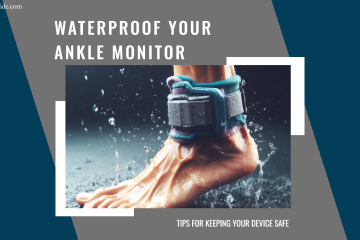When it comes to blocking GPS signals on ankle monitors, there is a growing concern about privacy and personal autonomy. The ability to track someone\’s every move raises questions about surveillance and individual rights. But did you know that there are methods that individuals can employ to block these signals and assert a level of control over their own privacy?
One of the most effective ways to block GPS signals on an ankle monitor is by using a GPS jammer. These devices emit a powerful signal that interferes with the GPS reception, making it difficult for the ankle monitor to accurately track the wearer\’s location. This technology has been used by law enforcement and military agencies for years, but it is also available to the general public.
If you\’re looking to block GPS signals on an ankle monitor, it\’s important to note that tampering with or blocking the signals may be illegal and result in severe consequences. Ankle monitors are designed to ensure compliance and monitor the location of individuals. Instead of trying to block the signal, it\’s advisable to discuss any concerns or limitations with the supervising agency or seek legal counsel for appropriate solutions.
Preventing GPS Signal on Ankle Monitors
GPS ankle monitors are electronic devices used to track the location of individuals who are on parole, probation, or under house arrest. While ankle monitors serve an important purpose in monitoring the movement of individuals, there may be circumstances where one might want to block the GPS signal of an ankle monitor. It is important to note that tampering with or blocking a GPS ankle monitor signal without proper authorization is generally illegal and can result in serious consequences. However, for educational purposes, we will explore some of the methods that have been discussed in various sources, with the understanding that they should not be used for illegal activities.
In this article, we will provide information on potential methods that people have suggested to block a GPS signal on an ankle monitor. Please note that these methods are for informational purposes only.
It is crucial to emphasize that interfering with a GPS ankle monitor is illegal and can result in severe consequences. If you are wearing an ankle monitor and have concerns about its impact on your privacy or rights, it is highly recommended that you seek legal advice rather than attempting to block the GPS signal on your own.
1. Using GPS Signal Jammers
In discussions about how to potentially block a GPS signal on an ankle monitor, GPS signal jammers are often mentioned. These devices are designed to emit radio frequency signals that interfere with the GPS signal, making it difficult for the ankle monitor to accurately track the individual\’s location. However, it is important to note that the use of GPS signal jammers is illegal in most countries, as they can disrupt legitimate GPS signals used in various industries and emergency services. Engaging in such activity can result in severe penalties and legal consequences.
It is crucial to understand that using GPS signal jammers can not only disrupt the GPS signal of your ankle monitor but also affect other GPS-enabled devices and systems in the vicinity, potentially compromising public safety and emergency response.
Instead of exploring illegal methods, individuals who have concerns about their ankle monitors should consult with their legal representatives to understand their rights, discuss any potential issues, and seek appropriate legal solutions.
2. Maintaining Line of Sight Blockages
Another method that some individuals have suggested is attempting to block the ankle monitor\’s GPS signal by creating line of sight blockages. This can be done by shielding the ankle monitor with physical obstructions, such as metal or dense materials, that may interfere with the signal. However, it is essential to note that this method is also likely to be illegal, as it involves tampering with the ankle monitor and potentially obstructing justice.
Moreover, it is important to acknowledge that ankle monitors are designed to provide continuous monitoring, and intentionally blocking the GPS signal can be considered a violation of the terms of your monitoring agreement. Violating these terms can result in additional penalties or modifications to your monitoring conditions.
If you have concerns about your ankle monitor, it is advisable to communicate with your legal representative to ensure that your rights are protected and that any issues are addressed through legal means.
3. Legal Remedies and Communication
If you have concerns about your ankle monitor or believe that it is affecting your privacy or rights, the most appropriate course of action is to seek legal remedies through the appropriate channels. Consult with your legal representative, parole officer, or probation officer to discuss your concerns and explore potential solutions within the legal framework.
It is important to note that regulations and laws regarding ankle monitors can vary between jurisdictions, so it is crucial to understand the specific regulations applicable to your situation.
Engaging in activities that tamper with or hinder the functioning of an ankle monitor can lead to severe legal consequences. It is always recommended to seek legal guidance and resolve concerns within the boundaries of the law.
Conclusion
Tampering with or attempting to block the GPS signal of an ankle monitor is illegal and can result in severe penalties. It is important to respect the law and seek proper legal guidance if you have concerns about your ankle monitor.
Key Takeaways: How to Block GPS Signal on Ankle Monitor
Here are the key takeaways for blocking GPS signals on an ankle monitor:
- Using signal jamming devices can disrupt GPS communication.
- Blocking GPS signals may be illegal and may result in legal consequences.
- Physically obstructing the GPS antenna with metal or other materials can interfere with the signal.
- Seeking legal advice is recommended before attempting to block GPS signals on an ankle monitor.
- Exploring alternatives such as seeking permission for limited movement or discussing concerns with authorities may be more appropriate.
Frequently Asked Questions
GPS ankle monitors are commonly used for tracking individuals on parole or probation. While tampering with these devices is illegal, people may have questions about blocking the GPS signal for various reasons. Here are some frequently asked questions related to blocking GPS signals on ankle monitors.
1. Is it possible to block the GPS signal on an ankle monitor?
While it may be technically possible to block the GPS signal on an ankle monitor, it is important to note that tampering with or interfering with the functionality of an ankle monitor is a violation of the law in most jurisdictions. Intentionally blocking the GPS signal can be considered a serious offense and can result in legal consequences. It is always best to follow the rules and guidelines set by the monitoring authorities.
If you have concerns or issues with your ankle monitor, it is recommended to reach out to the appropriate authorities or your assigned officer to discuss them. They will be able to provide guidance and address any concerns you may have within the boundaries of the law.
2. Are there any legal ways to minimize the GPS signal range of an ankle monitor?
While it is generally not advisable to tamper with or block the GPS signal on an ankle monitor, there may be legal ways to minimize the signal range as per the guidelines set by the monitoring authorities. It is important to consult with the relevant authorities or your assigned officer to understand the permitted actions that can be taken regarding the signal range of the device.
Keep in mind that the primary purpose of an ankle monitor is to track the whereabouts of an individual. Tampering with or attempting to manipulate the device beyond the authorized methods can lead to legal consequences.
3. Can wrapping the ankle monitor in aluminum foil block the GPS signal?
Wrapping an ankle monitor in aluminum foil is often suggested as a way to block the GPS signal. However, it is important to note that this method may not be effective in most cases. GPS signals can penetrate through materials, and simply wrapping the device in aluminum foil may not completely block the signal.
Moreover, attempting to block the GPS signal using unauthorized methods can be considered a violation of the law. It is always best to consult with the monitoring authorities for any concerns or issues regarding the ankle monitor and follow their instructions and guidelines.
4. Are there any legal alternatives to blocking the GPS signal on an ankle monitor?
If you have concerns about the GPS tracking while wearing an ankle monitor, it is advisable to discuss your situation with the monitoring authorities or your assigned officer. They may be able to provide alternative options or address your concerns within the bounds of the law and the established guidelines.
It is essential to remember that tampering with or attempting to block the GPS signal on an ankle monitor without authorization is illegal and can lead to serious consequences. Always consult with the appropriate authorities to ensure compliance with the legal requirements.
5. What should I do if I believe the ankle monitor is malfunctioning or causing issues?
If you believe that the ankle monitor is malfunctioning or causing issues, it is crucial to inform the monitoring authorities or your assigned officer immediately. They will be able to assess the situation, potentially provide a replacement device, or address any concerns you may have.
It is important to remember that tampering with or attempting to interfere with the ankle monitor without proper authorization is illegal and can result in serious consequences. Follow the appropriate procedures and channels to address any issues you may encounter with your ankle monitor.
To block a GPS signal on an ankle monitor, there are a few methods available. One option is to use a GPS signal jammer, a device that emits radio frequencies to interfere with the GPS signal. Another method is to shield the ankle monitor with a metal container or foil to block the signal. It\’s important to note that tampering with an ankle monitor is illegal and can result in serious consequences.
If you are required to wear an ankle monitor and believe there is a problem with its functioning, it\’s essential to contact the relevant authorities or your supervising officer. They will be able to address any issues or concerns you may have and provide guidance on the correct course of action.





